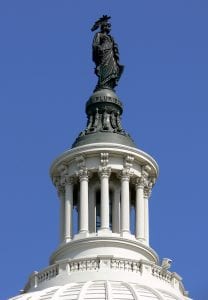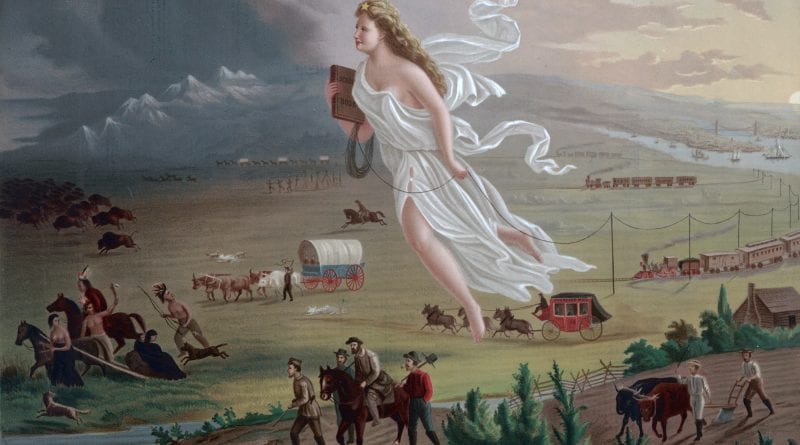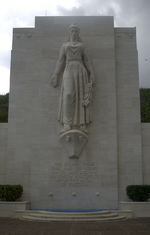Quagmire: The Name “Columbia” as in District of Columbia is Symbol for USA’s Racist Manifest Destiny Policies. Columbia – the “White Goddess” – Stands Atop the US Capitol Representing the Ethnic Cleansing of American Indians – So many statues – so little time.
Follow Mystic Post on Facebook
“Columbia” is a name given to the “Spirit of the Frontier” of which was used to illustrate Manifest Destiny among several other American political causes.
A Quagmire for the progressive left “”Washington District of the White Goddess”
About the Statue that sits atop the US Capitol Dome.
 A monumental statue for the top of the national Capitol appeared in architect Thomas U. Walter’s original drawing for the new cast-iron dome, which was authorized in 1855. Walter’s drawing showed the outline of a statue representing the white Goddess of Liberty; Crawford proposed instead an allegorical figure of Freedom Triumphant in War and Peace. The Statue of Freedom
that sits atop the United States Capitol building, though not actually called “Columbia”shares many of her iconic characteristics. source: wikipedia
A monumental statue for the top of the national Capitol appeared in architect Thomas U. Walter’s original drawing for the new cast-iron dome, which was authorized in 1855. Walter’s drawing showed the outline of a statue representing the white Goddess of Liberty; Crawford proposed instead an allegorical figure of Freedom Triumphant in War and Peace. The Statue of Freedom
that sits atop the United States Capitol building, though not actually called “Columbia”shares many of her iconic characteristics. source: wikipedia
Crawford was commissioned to design Freedom in 1854 and executed the plaster model for the statue in his studio in Rome. Mississippian senator and U.S. Secretary of War Jefferson Davis (who would later become President of the Confederacy) was in charge of the Capitol construction and its decorations.
The History of “Columbia”
Especially in the 19th century, Columbia would be visualized as a goddess-like female national personification of the United States and of Liberty itself. This personification was sometimes called “Lady Columbia” or “Miss Columbia”
“Columbia” is a historical name used by both Europeans and Americans to describe the Americas, the New World, and often, more specifically, the United States of America. It is also a name given to the “Spirit of the Frontier” of which was used to illustrate Manifest Destiny among several other American political causes. It has given rise to the names of many persons, places, objects, institutions, and companies; e.g., Columbia University, the District of Columbia (the national capital), and the ship Columbia Rediviva, which would give its name to the Columbia River. Images of the Statue of Liberty largely displaced personified Columbia as the female symbol of the U.S. by around 1920.[1]
Columbia and an early rendition of Uncle Sam in an 1869 Thomas Nastcartoon, having Thanksgiving dinner with a diverse group of immigrants.[2][3]
The Bust of Columbia depicted on U.S. Fractional currency
Carte de visite c. 1866, featuring a woman dressed as Columbia and a man dressed as a Revolutionary Wargeneral
This 1872 painting depicts Columbia as the “Spirit of the Frontier”, carrying telegraph lines across the Western frontier to fulfill Manifest Destiny
Columbia wearing a warship bearing the words “World Power” as her “Easter bonnet” (cover of Puck, April 6, 1901)
In the second half of the 18th century, the American colonists were beginning to acquire a sense of having an identity distinct from that of their British cousins on the other side of the ocean. At that time, it was common for European countries to use a Latin name in formal or poetical contexts to confer an additional degree of respectability on the country concerned.[8] In many cases, these nations were personified as pseudo-classical goddesses named with these Latin names. Located on a continent unknown to and unnamed by the Romans, “Columbia” was the closest that the Americans could come to emulating this custom.
By the time of the Revolution, the name Columbia had lost the comic overtone of its “Lilliputian” origins and had become established as an alternative, or poetic name for America. While the name America is necessarily scanned with four syllables, according to 18th-century rules of English versification, Columbia was normally scanned with three, which is often more metrically convenient. The name appears, for instance, in a collection of complimentary poems written by Harvard graduates in 1761, on the occasion of the marriage and coronation of King George III.[9]
The name “Columbia” rapidly came to be applied to a variety of items reflecting American identity. A ship built in Massachusetts in 1773, received the name Columbia Rediviva; it later became famous as an exploring ship, and lent its name to new “Columbias.”
No serious consideration was given to using the name Columbia as an official name for the independent United States,[citation needed] but with independence the name became popular and was given to many counties, townships, and towns, as well as other institutions, e.g.:
-
In 1784, the former King’s College in New York City had its name changed to Columbia College, which became the nucleus of the present-day Ivy League Columbia University.
-
In 1786, South Carolina gave the name “Columbia” to its new capital city. Columbia is also the name of at least nineteen other towns in the United States.
-
In 1791, three commissioners appointed by President Washington named the area destined for the seat of the U.S. government “the Territory of Columbia”; it was subsequently (1801) organized as the District of Columbia.
-
In 1792, the Columbia Rediviva sailing ship gave its name to the Columbia River in the American Northwest (much later, the Rediviva would give its name to the Space Shuttle Columbia)
-
In 1798, Joseph Hopkinson wrote lyrics for Philip Phile‘s 1789 inaugural “President’s March” under the new title of “Hail, Columbia.” Once used as de facto national anthem of the United States, it is now used as the entrance march of the Vice President of the United States.
-
In 1865 Jules Verne‘s novel From the Earth to the Moon, the spacecraft to the moon was fired from a giant Columbiad cannon.
Columbia (representing the American people) reaches out to oppressed Cuba with blindfolded Uncle Sam in background; JudgeFeb. 6, 1897; cartoon by Hamilton
In part, the more frequent usage of the name Columbia reflected a rising American neoclassicism, exemplified in the tendency to use Roman terms and symbols. The selection of the eagle as the national bird, the heraldric use of the eagle, the use of the term Senate to describe the upper house of Congress, and the naming of Capitol Hill and the Capitol building were all conscious evocations of Roman precedents.
The adjective Columbian has been used to mean “of or from the United States of America”, for instance in the 1893 World’s Columbian Exposition held in Chicago, Illinois. It has occasionally been proposed as an alternative word for “American”.
Columbian should not be confused with the adjective “Pre-Columbian“, referring to a time period before the arrival of Christopher Columbus in 1492.
Personification[edit]
Personification of Columbia, from a Columbia Records phonograph cylinder package
As a quasi-mythical figure, Columbiafirst appears in the poetry of African-American Phillis Wheatley starting in 1776 during the revolutionary war:
One century scarce perform’d its destined round,
When Gallic powers Columbia’s fury found;
And so may you, whoever dares disgrace
The land of freedom’s heaven-defended race!
Fix’d are the eyes of nations on the scales,
For in their hopes Columbia’s arm prevails.[11]
Especially in the 19th century, Columbia would be visualized as a goddess-like female national personification of the United States and of Liberty itself, comparable to the British Britannia, the ItalianItalia Turrita, and the French Marianne, often seen in political cartoons of the 19th-early 20th century. This personification was sometimes called “Lady Columbia” or “Miss Columbia”. Such iconography usually personified America in the form of an Indian queen or Native American princess[12]
Columbia at the National Memorial Cemetery of the Pacific
The image of the personified Columbia was never fixed, but she was most often presented as a woman between youth and middle age, wearing classically-draped garments decorated with stars and stripes. A popular version gave her a red-and-white-striped dress and a blue blouse, shawl, or sash, spangled with white stars. Her headdress varied; sometimes it included feathers reminiscent of a Native American headdress; sometimes it was a laurel wreath, but most often it was a cap of liberty.
Early in World War I (1914–1918) the image of Columbia standing over a kneeling “Doughboy” was issued in lieu of the Purple Heart Medal. She gave “to her son the accolade of the new chivalry of humanity” for injuries sustained in “the” World War.
Statues of the personified Columbia may be found in the following places:
-
The 1863 Statue of Freedom atop the United States Capitol building, though not actually called “Columbia”, shares many of her iconic characteristics.[14][15]
-
Atop Philadelphia’s Memorial Hall
,
built 1876
-
The replica Statue of the Republic (“Golden Lady”) in Chicago’s Jackson Park is often understood to be Columbia. It is one of the remaining icons of the 1893 World’s Columbian Exposition.
-
In the National Memorial Cemetery of the Pacific, dedicated 1949.













